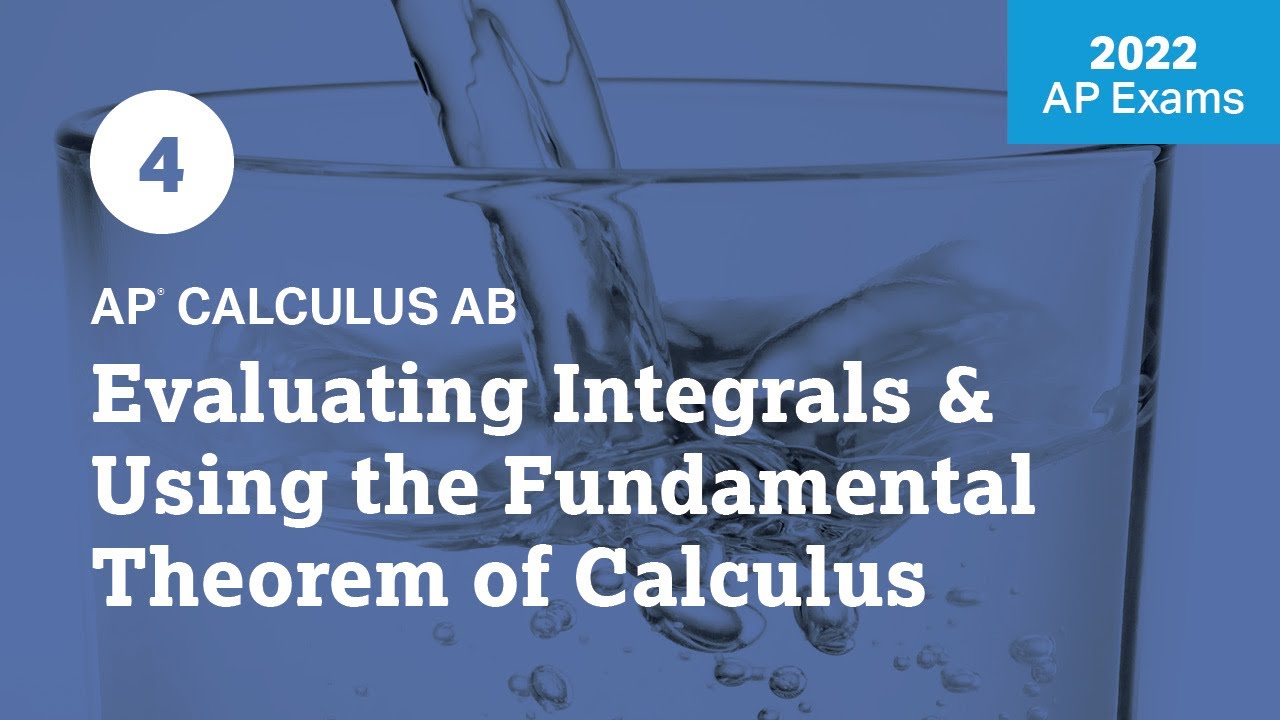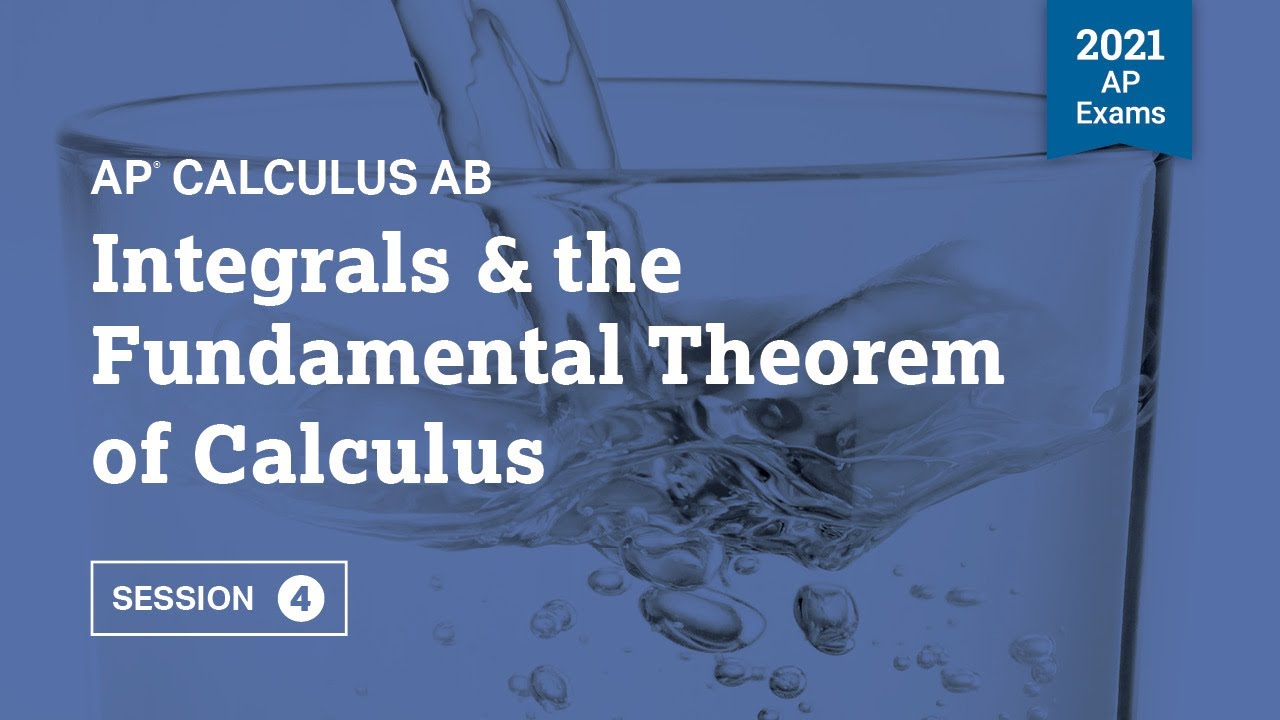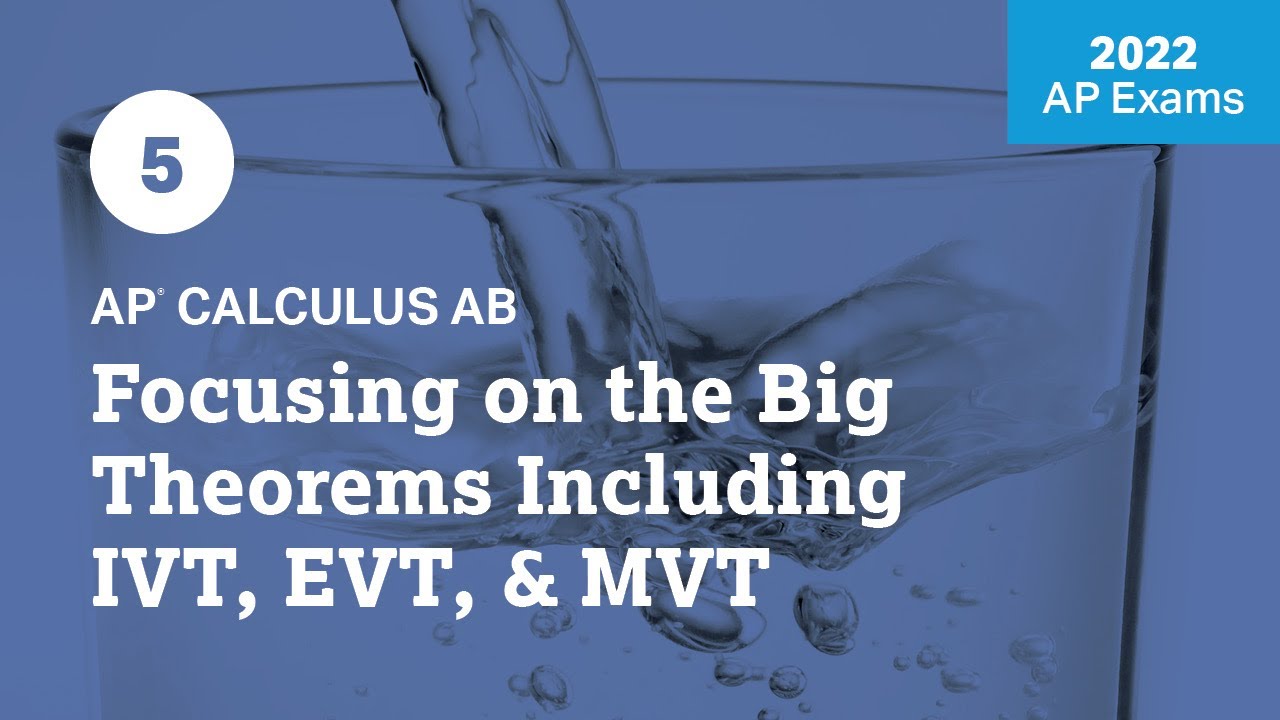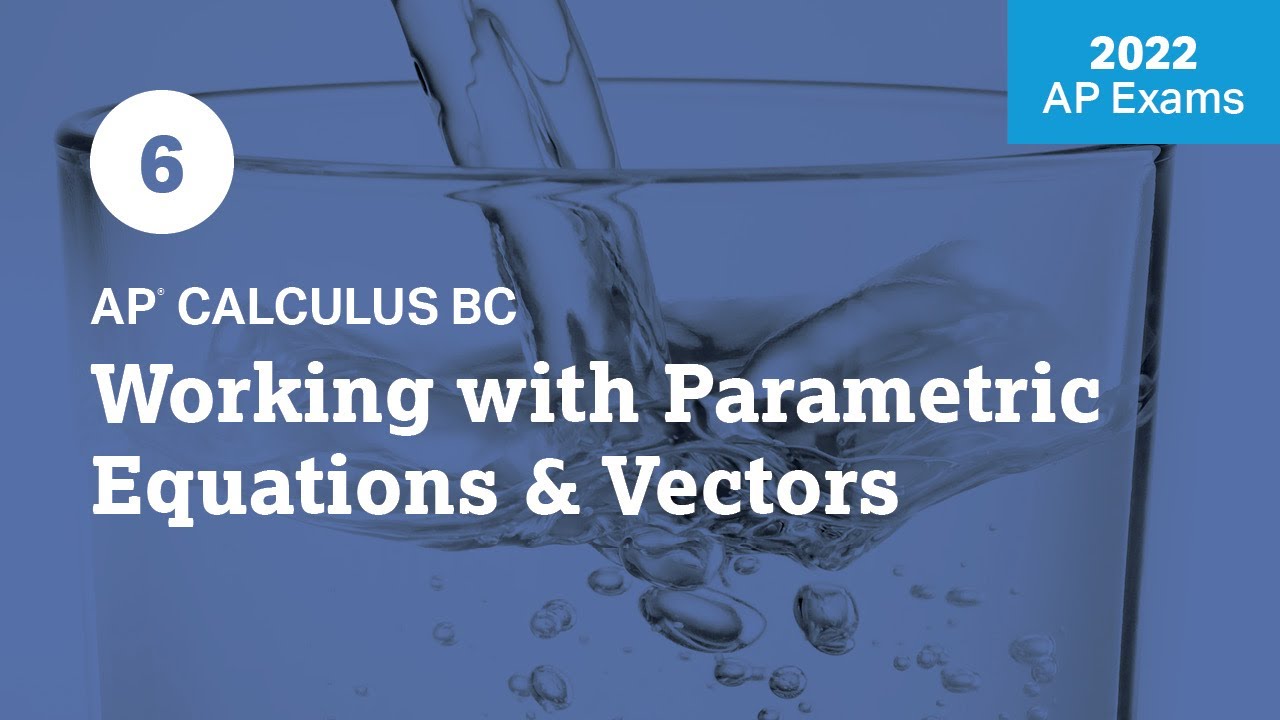2022 Live Review 2 | AP Calculus AB | Working with Applications of the Derivative
TLDRThe video script features an engaging calculus lesson with Mark Corelli and Verge Cornelius, educators from Texas and Mississippi, respectively. They delve into various calculus concepts, including applications of derivatives, related rates, tangent line approximations, curve sketching, and extreme values. The instructors emphasize the importance of understanding and applying these concepts, particularly in the context of the AP Calculus exam. They work through problems involving finding velocities and accelerations, using both manual calculations and calculator tools. The session also touches on the interpretation of derivatives in terms of rates of change and the significance of concavity in functions. The educators provide a comprehensive overview of calculus topics, aiming to equip students with the skills needed for success in their studies and exams.
Takeaways
- 📚 **Practice and Preparation**: The session emphasizes the importance of practicing calculus problems, especially for AP Calculus AB and BC students.
- 👨🏫 **Instructor Introductions**: Mark Corelli from Ryan High School in Denton, Texas, and Verge Cornelius from Lafayette High School in Oxford, Mississippi, lead the session.
- 🔢 **Derivative Applications**: The focus is on applications of derivatives, including related rates, tangent line approximations, curve sketching, and extreme values.
- 📈 **Derivative Analysis**: Techniques for analyzing a function's behavior using the first and second derivatives are discussed, such as determining extreme values and concavity.
- 🧮 **Calculator Usage**: The use of calculators for finding derivatives and solving problems is demonstrated, highlighting both manual and calculator-assisted methods.
- 📉 **Function Analysis**: The concept of using derivatives to understand a function's velocity, acceleration, and points of inflection is covered.
- 🤔 **Conceptual Understanding**: The session stresses the importance of understanding the conceptual meaning behind mathematical operations, not just performing the calculations.
- 📝 **Clear Communication**: Students are advised to be clear and precise in their explanations, especially when showing work for free-response questions.
- 🚴 **Real-world Application**: An example involving the velocity and acceleration of a bike rider is used to illustrate the application of derivatives in real-world scenarios.
- ⏱️ **Time Management**: The instructors discuss time management and how to efficiently use a calculator while ensuring that all steps are shown in the work.
- 📚 **Study Materials**: It is mentioned that solutions to the problems will be available online for students to check their work after attempting the problems on their own.
Q & A
What is the topic of discussion for the second day of the calculus problems?
-The topic for the second day is AP Calculus AB, focusing on applications of the derivative, including related rates, tangent line approximation, motion curve sketching, first and second derivatives, extreme values, and various theorems such as the extreme value theorem and mean value theorem.
What is the formula given for the height of an object at time t greater than one?
-The formula given for the height of an object at time t greater than one is h(t) = (5t^2 + 27) / (t + 2).
What is the method used to find the velocity of the object at time t equals 1.3?
-The method used to find the velocity at time t equals 1.3 is by taking the derivative of the height function h(t) with respect to time t, and then evaluating it at t = 1.3.
How does the script mention using a calculator to find derivatives?
-The script mentions using a calculator's numeric derivative function, which can be accessed through the math menu on the calculator, to find derivatives and evaluate them at specific points, such as finding the velocity of an object at a given time.
What is the relationship between the derivative of position, velocity, and acceleration?
-The derivative of position with respect to time is velocity, and the derivative of velocity with respect to time is acceleration. This relationship is used to analyze the motion of an object over time.
How does the script illustrate the concept of concavity?
-The script illustrates the concept of concavity by discussing the second derivative of a function. If the second derivative is positive, the function is concave up, and if it's negative, the function is concave down. Points where the second derivative changes sign are potential points of inflection.
What is the significance of the second derivative test in analyzing a function?
-The second derivative test is used to determine the concavity of a function, which can help identify points of inflection and assess whether a critical point is a maximum or minimum. If the second derivative is negative, the function is concave down, indicating a local maximum at that point if the first derivative is also zero.
How does the script handle the concept of limits in calculus?
-The script briefly mentions limits in the context of the derivative definition and related rates. It also hints at discussing limits in more depth in future sessions, including l'Hôpital's rule and summation notation.
What is the approach to solving the problem involving the function h(x) that is decreasing and concave down?
-The approach involves understanding that since h(x) is decreasing and concave down, the values of h at points greater than the given points (such as from h(2) to h(4)) are decreasing at an increasing rate. This is used to infer that h(6) must be less than h(4) and drop more than the difference between h(2) and h(4), leading to the conclusion that h(6) must be less than 5.
How does the script emphasize the importance of practice in calculus?
-The script emphasizes practice by providing multiple problems for the audience to solve, encouraging the use of both manual calculations and calculators, and discussing the importance of understanding the concepts behind each problem. It also mentions that solutions will be available for review, allowing for self-assessment.
What is the method used to approximate the velocity of an object using a table of values?
-The method used is to find the average rate of change over the smallest interval containing the time point of interest. By calculating the slope of the secant line between two points in the table that bracket the time point, the instantaneous velocity can be approximated.
Outlines
😀 Introduction and AP Calculus AB Review
Mark Corelli and Verge Cornelius, teachers from different high schools, greet their audience and introduce day two of a calculus workshop. They recap the previous day's focus on applications of derivatives and prepare to delve into topics such as related rates, tangent line approximation, curve sketching, and extreme values. They also mention that a significant portion will be dedicated to theorems like the extreme value theorem and mean value theorem on day five. The speakers encourage students to engage with the material and prompt them to set up their calculators for a warm-up problem involving the velocity of an object.
🧮 Calculator Active Problem: Object's Velocity
The instructors present a problem involving the calculation of an object's velocity at a specific time using a given height function. They demonstrate both manual and calculator-assisted methods to find the derivative and evaluate it at the given time, emphasizing the utility of calculators in such problems. They also discuss the importance of understanding the context of derivatives in physics, such as velocity and acceleration, and the significance of accurate calculation up to three decimal places as per AP exam standards.
🚴♂️ Mark's Bike Ride: Velocity and Acceleration
Mark's velocity while riding a bike is described by a function of time. The problem at hand is to find the derivative (velocity) at a specific time, which represents acceleration. The instructors use the concept of the derivative to explain the physical phenomenon and emphasize the need to include units and context when presenting the answer. They also touch upon the concept of speed, which is the absolute value of velocity, and how it differs from velocity when considering direction.
📊 Data Table: Approximating Verge's Velocity
Using a table of position values for Verge at different times, the instructors illustrate how to approximate velocity at a time not explicitly given in the table. They explain the concept of using the average rate of change to estimate the instantaneous rate of change, specifically focusing on the interval closest to the time of interest. The problem highlights the application of derivatives in real-world scenarios and the importance of selecting the most relevant data points for accurate approximations.
🏎️ Comparing Velocities: Mark vs. Verge
The instructors compare the velocities of Mark and Verge at a specific time, using the previously calculated values. They clarify the difference between speed and velocity and how to interpret the derivative in terms of increasing or decreasing values. The comparison serves as a practical example of how to apply calculus concepts to compare rates of change in different scenarios.
📉 Decreasing Function and Concavity Analysis
The instructors analyze the behavior of a function by examining its first and second derivatives. They use the sign of the first derivative to determine whether the function is increasing or decreasing and the second derivative to assess concavity. The analysis includes identifying intervals of decrease and points of inflection, which are essential for understanding the function's overall behavior and shape.
🤔 Maximum Value Problem: Natural Logarithm Function
The session concludes with a problem involving the natural logarithm function, where the goal is to find the maximum value of the function. The instructors demonstrate how to take the first and second derivatives, set them to zero to find critical points, and then use these points to analyze the function's behavior. They emphasize the importance of testing these points to confirm whether they correspond to a maximum or minimum value.
📌 Limits, Continuity, and Future Topics
In the final part, the instructors briefly mention the next day's focus on limits and continuity, which will cover a range of topics from the entire course. They summarize the key takeaways from the day, including the importance of differentiating to find rates, understanding the implications of the first and second derivatives, and the significance of limits in calculus. They also encourage students to practice and look forward to the next session.
Mindmap
Keywords
💡Derivative
💡AP Calculus
💡Tangent Line Approximation
💡Motion
💡Second Derivative
💡Extreme Value Theorem
💡Calculator Active
💡Free Response
💡Concavity
💡Linear Approximation
💡Product Rule
Highlights
Mark Corelli and Verge Cornelius discuss preparing for AP Calculus, emphasizing the application of derivatives.
They cover a range of calculus topics including related rates, tangent line approximation, and curve sketching.
Mark demonstrates how to find the velocity of an object given its height as a function of time using both manual calculation and a calculator.
Verge Cornelius explains the concept of acceleration as the derivative of velocity, providing a clear understanding of the physical meaning behind the mathematical operations.
The instructors use a calculator to approximate the velocity of an object at a specific time, showcasing the power of technology in solving calculus problems.
Mark and Verge discuss the importance of including units in calculus problems for context and clarity.
They explore the concept of concavity and how it relates to the second derivative of a function.
Mark presents a method for finding the maximum value of a function using the first and second derivatives.
Verge emphasizes the need to practice various methods of solving calculus problems to avoid making careless mistakes.
The instructors provide a step-by-step guide to using a calculator for more complex derivative problems, including related rates.
Mark and Verge discuss the concept of instantaneous rate of change and how it approximates using average rates from a data table.
They highlight the importance of understanding the difference between speed and velocity, especially in the context of acceleration.
The session includes a practical example of how to use a calculator to find the derivative of a function at a specific point.
Verge Cornelius explains the concept of a linear approximation using the point-slope form of a line.
Mark Corelli demonstrates how to use implicit differentiation to solve a problem involving multiple variables.
The instructors conclude with a review of the day's topics and a preview of the next session, which will focus on limits and continuity.
Transcripts
Browse More Related Video

2022 Live Review 4 | AP Calculus AB | Integrals & Using the Fundamental Theorem of Calculus

2022 Live Review 1 | AP Calculus AB | Practicing with Derivatives & Chain Rule

2021 Live Review 4 | AP Calculus AB | Integrals & the Fundamental Theorem of Calculus

2022 Live Review 5 | AP Calculus AB | Focusing on the Big Theorems Including IVT, EVT, & MVT

8 | FRQ (No Calculator) | Practice Sessions | AP Calculus AB

2022 Live Review 6 | AP Calculus BC | Working with Parametric Equations and Vectors
5.0 / 5 (0 votes)
Thanks for rating: